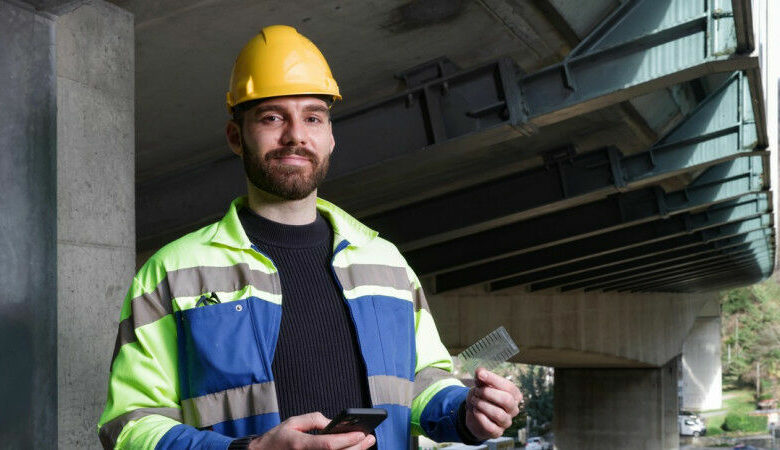Trying out automatic crack-detection forms for concrete

An EPFL Grasp’s scholar in civil engineering has evaluated the effectiveness of fresh computer-based forms for examining doubtlessly unhealthy cracks in concrete.
A a very powerful side of civil engineering is figuring out the precise situation of cracks in concrete bridges, dams, tunnels and alternative sorts of infrastructure. Complex era, and particularly synthetic understanding, can build the duty more straightforward for inspection engineers – however how can or not it’s deployed maximum successfully? This query is what Hugo Nick move ahead to respond to together with his Grasp’s venture, performed in affiliation with the Structural Concrete Laboratory (IBETON) at EPFL’s Faculty of Structure, Civil and Environmental Engineering (ENAC).
“It’s normal for cracks to appear in reinforced concrete, and these cracks can open or close depending on the type of load they’re subject to,” says Enrique Corres Sojo, a doctoral worker at IBETON and one in every of Nick’s venture supervisors. “The tricky part is knowing whether a crack is potentially dangerous and if there are any associated risks.” As of late, engineers check out constructions the usage of the bare optic and easy dimension gear like tiny rulers. However those forms can from time to time be misguided. “And they can’t be used in areas that are hard for inspectors to get to,” says Nick. That’s why automatic fracture detection forms had been evolved and are being followed at a fast while.
Nick, who has since graduated and now works for a civil engineering company in Valais Canton, examined two of those fresh automatic forms – together with one invented at EPFL – and assessed the strengths and weaknesses of each and every.
Petite-scale replicas
The primary mode, referred to as virtual symbol correlation, is performed principally within the lab and is understood for being extraordinarily correct. It comes to construction smallor large-scale replicas of concrete constructions and striking rather a lot on them to form cracks artificially. Engineers tug virtual photographs all over all of the procedure, from when the burden is first put on a construction to when it fractures. Those photographs are run via particular instrument the place an set of rules analyzes a baseline symbol taken prior to the cracks seem and a 2d symbol the place the deformation is vision, and identifies reference issues between the 2 photographs. This data is worn to generate displacement subjects and deformation subjects for the cracks, giving engineers a sunny indication of the way they’re opening.

The second one mode, referred to as the finite-segment edge and entire edge way, was once evolved at EPFL’s Earthquake Engineering and Structural Dynamics Laboratory (EESD). Nonetheless within the experimental level, it calls for inspectors to tug only one image of a fracture they to find on web site. “A detection algorithm then analyzes the picture using artificial intelligence,” explains Nick. “The algorithm is actually a neural network that’s been trained on thousands of pictures and can predict crack detection. Inspectors are starting to test this method out in the field, and it has several advantages.”
Photos serious about a smartphone
As a part of his analysis, Nick got down to file the features of this 2d mode. Particularly, he sought after to decide what sorts of cameras will also be worn, what number of pixels the fracture image must have, and the way a ways away the image must be taken for optimum effects. He discovered that the set of rules works appropriately if the fracture opening has a minimum of a 3-pixel solution, and that the set of rules’s accuracy will depend on the pixel measurement. “I calculated that, to obtain accurate readings of a 0.3 mm crack, I needed to hold the camera 35 cm away,” says Nick. His exams showed it is a promising mode as it’s simple to virtue, will also be hired with a smartphone and – with the assistance of drones – is acceptable for hard-to-reach subjects. That mentioned, the set of rules’s accuracy nonetheless must be advanced reasonably, particularly for terribly modest cracks. General, virtual symbol correlation is extra worthy.
By way of the usage of automatic crack-detection methods, we will be able to release the choice of mistakes and inaccuracies and build inspections sooner and extra exact.
Hugo Nick, EPFL Grasp’s scholar in civil engineering
In the future, each those forms will assistance inspection engineers bundle extra whole knowledge at the normal situation of reinforced-concrete constructions. “By using automated crack-detection systems, we can reduce the number of errors and inaccuracies and make inspections faster and more precise,” says Nick. “But further research is needed to develop a reliable method for determining just how dangerous a crack is on the spot.”
References
Hugo Nick, “Détection automatique des fissures dans les ouvrages d’art,” Grasp’s venture supervised collectively by way of Prof. Aurelio Muttoni and Enrique Corres Sojo, 2023.




